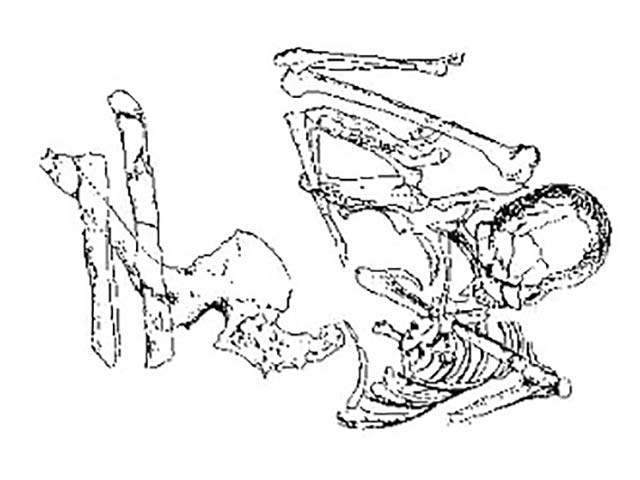di Maria Laura Leone
Dealing with funerary spirituality, the concept of the afterlife is touched upon, the most distant world that man has ever attempted to ideally elaborate and explore. Thus, in the various approaches to death, we constantly encounter the concern for existence, the desire for permanence, continuity, the conservation of body and soul. These concerns have been felt since the middle Paleolithic (as far as we know), but in the superior they are fully manifested with all the strength of the life-death relationship. In this discussion we will see some significant examples present in Puglia, but not only, which outline a picture that perfectly agrees with the characteristics of the time.
According to the findings, the first human type to bury the dead using some ritual was the Neanderthal. Different and particular attentions dedicated to the Mousterian burials are attested, concentrated in caves distinct from the inhabited ones. The dead were placed in a specially dug pit, sometimes covered by a slab (as in La Ferrassie), placed curled up in a sleeping position accompanied by flint tools, probably with the idea of their use in another life. Portions of slaughtered animals were also associated with the grave goods, as a sign of offering or supply of food for the afterlife. In a burial in Shanidar even remains of pollen have been identified, attributed by the discoverer Ralph Solecki to a layer of flowers lying on the burial. The best known depositions of this period in Europe are in France: La Chapelle-aux-Saints, Le Moustier, La Ferrassie; in the Near East: on Mount Carmel, in Nazareth (Israel) and precisely in Shanidar (Iran). No Neanderthal depositions have been discovered in Italy, we have only one rather singular case of probable ritual cannibalism linked to the famous skull found by Blanc in the Grotta Guattari on Monte Circeo. In Puglia, the only Neanderthal remains of uncertain funerary context are two infant teeth recovered from Grotta del Cavallo and Grotta del Bambino (in the province of Lecce) and a portion of the femur recovered from Grotta S. Croce di Bisceglie (in the province of Bari).
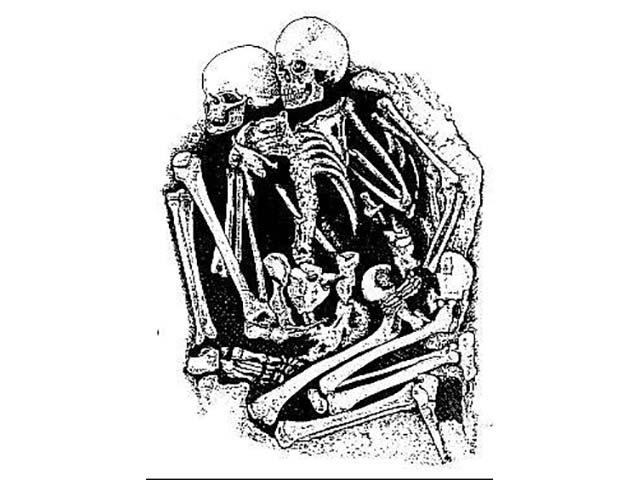
The situation is different for the Upper Paleolithic. To the rarest Neanderthal examples are added the numerous burials of the Cro-Magnons, distributed almost everywhere its presence has been found. In this glacial period the funerary rites and practices after the deposition became more complex and differentiated. The greater quantity of finds allows, in fact, to clearly trace the numerous details: the ornaments, constantly present on the body of the deceased, always decorated with headdresses, necklaces, anklets, bracelets and amulets; the position of the body, which varies with respect to the dormant one predominant in the Middle Paleolithic; the structure of the pit, which is often enriched with a bed of ocher and a sort of stone cushion for the head; and again, the diversity of the accompanying elements, always of fine workmanship. Each of these factors multiplies with respect to the habits of the Neanderthal, also increases the number of bisome or multiple depositions with adults of different sexes (as in Puglia at Grotta delle Veneri) or even of an adult and an adolescent (as in the Balzi Rossi, in Liguria). Sometimes the deceased embraced each other. These finds imply questions on the dynamics, on burial times, on deaths, which may not always have been contemporary, and on the hypotheses of secondary deposition or of the so-called sacrifice of the widow; as in the case of the burials of the Riparo del Romito, in Cosenza, discovered by Paolo Graziosi (Brizzi, 1977). There is also increasing evidence of the preservation of parts of the deceased's body (teeth and jaws) which were, in all probability, hung somewhere in the cave to obey a sort of ancestor cult. In the Placard cave, a female skull surrounded by shells and five other skullcaps transformed into cups (Broglio, Kozlowski, 1986) have been identified.
The burials of the Upper Paleolithic have common characteristics: in the choice of caves as secluded places to bury the deceased, in the burial ritual and in the personal ornaments which, by repeating themselves, suggest the fashion of the time. A new determinant of the spirituality and funerary symbolism of the Cro-Magnons is the profusion of red ochre, the hematite. It has been ascertained that the deceased could even be lying on a bed of ocher or even be completely covered in it; in other cases it was used only on some parts of the body, especially on the head, or pebbles painted with this substance were added to the kit. Ocher was traded. Together with flint and shells, it was a precious and sought-after material imported from considerable distances.
The mining of hematite is confirmed for the Late Magdalenian and for the epipaleolithic complexes of Poland (Broglio, Kozlowski, 1986).
Iron sesquioxide hydrate, one of the main minerals from which iron is extracted, produces limonite, i.e. the yellow colour, which made up for the ocher where it was missing. In fact, by cooking it, it turns red. The two basic colors, red and yellow, but also their nuances, have been widely used in wall paintings and magical practices.
The main burials of our peninsula are concentrated essentially in Liguria: ai Balzi Rossi and Arena Candide. In Puglia they come from the caves of clowns, Venus and S. Maria of Agnano. All, from north to south, have common ritual denominators. In the Gravettian burial bisoma dei Balzi Rossi (Grotta dei Fanciulli) the bodies of an adolescent and an adult woman were huddled next to each other; they had shell ornaments and traces of ochre. In an upper layer, another individual smeared with ochre lay on his back with his arms folded across his chest and his head resting on a boulder. From the upper Epigravettian layers came to light another bisome burial of two children, placed on their backs and covered with ornaments of perforated shells that covered the area of the hips, perhaps to form a loincloth.
All Arena Candide one of the most intact burials of the time was found, belonging to a young man whose equipment contained both a beautiful flint blade (still held in his hand) and four pierced elk horn sticks, interpreted as arrow straighteners. The head was adorned with a shell cap, while the bottom of the pit and the surface of the body were covered with the "magical" red substance. At Barma Grande, always ai Balzi Rossi, a trisoma burial was discovered with an adult male, a young woman and an adolescent, also here kits of shells and ocher completed the inhumation.
We have a case of notable presence of ocher in Sicily, where on the skeletal remains of Cave of San Teodoro a 5 cm layer was identified. Here a habit has been found attested elsewhere, that of placing heavy stones on the limbs of the deceased, perhaps due to some belief in the movement of the dead. A similar belief may correspond to the habit of burying the dead tied up and in a strongly contracted position, with the knees touching the chin, as in the case of the man from Chancelade in the Dordogne (Vigliardi, 1992).
Burials are often associated with artistic expressions, grave goods finely decorated with graphic signs with a symbolic content; usually painted or engraved pebbles. This is the case of the burial of an adult, about twenty-five years old, found in a Riparo di Villabruna in Belluno (Val Cismon). The pit had been filled with debris and covered with stones, two of which had geometric paintings like the rocky bank jutting out over the pit (Cocchi Genik, 1990). The presence of decorated objects or amulets is not infrequent, in Sunghir in Russia four burials were found in which there were objects with ivory animal figurines (Anati, 1995).
At least six of the relevant burials of the Italian Upper Paleolithic are concentrated in Puglia. The most extraordinary is certainly that of S. Maria of Agnano, relating to a pregnant woman who died about 25.000 years ago and was buried with her child on her lap. Other examples, no less significant, are of a boy and a woman found at Paglicci cave and a bisoma burial discovered in Grotta delle Veneri. The accuracy used for these depositions and their state of conservation provide a good record of the ornamental elements, everyday objects and skeletal characters of the human types who lived in the region between 25.000 and 10.000 years ago. These burials are in particular caves, the same ones with wall and movable art.
In Cave of S. Maria di Agnano, located at the base of a mountain near Ostuni, in the province of Brindisi, between 1991 and 1992, in fact, three burials were identified, two of which were incorporated in the breach that reached the ceiling of the cavity (hence, the difficulty of their extraction); the bodies lay back to back a short distance from each other. The site is still being excavated and has already revealed its enormous cultural value, including furniture art signs; but above all it bears witness to an intense predominantly religious attendance. It is possible that the decision to bury a young woman here in her last days of pregnancy was not a mere funeral act. In fact, the cave has seen a Marian sanctuary for many centuries, which lasted until the beginning of the 800th century; in classical times it was the seat of the cult of Demeter and still in the Neolithic it was the seat of a further female cult. The finds of votive offerings attest to the existence of a maternal deity to whom piglets were sacrificed (Coppola, 1992). Another rare presence of a fetus is the one attested in the Natufian Epipaleolithic of the Hayonim Cave on Mount Carmel, in Israel (Anati, 1995).
The oldest attendance of S. Maria of Agnano it dates back to the Middle Paleolithic, when Neanderthal groups exploited the shelter of the external shelter, much more extensive than today; after a phase of interruption the site was frequented, this time inland, by the Sapiens Sapiens. The woman, found in perfect anatomical connection, was placed in a pit lying on her side, with her right hand resting on her belly and the left under her cheek, as if sleeping. The skeleton of the fetus, clearly visible, was positioned in the exact maternal abode. Her body was decorated with various jewels: on her wrists she wore shell bracelets (Cyclope neritea, Cyprea lurida, European trivia), on his head he had a hairstyle made up of a hundred pierced shells mixed with ocher. The whole burial was surrounded by horse teeth and rare of Bos primigenius, a portion of the skull of a horse had been placed at its side, while several pieces of flint and bone fragments, with traces of incisions, constituted the remaining part of the outfit. The dating of the burial dates back to 24.410 - 320 years ago, Gravettian age. The second burial in Agnano had the same position as the pregnant woman, with the hand near the head and the legs more contracted, here too her head was surrounded by shells and pierced deer canines. A third deposition, however, belonging to a male deceased, laid on his back with his hands clasped on his chest, dates back to 12/10.000 years ago. The work of freeing the bodies took place in the Anatomy and Physiology laboratories of the University of Turin.
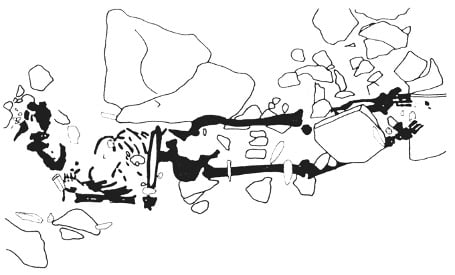
A Paglicci cave, near Rignano Garganico, a great cornerstone in the studies of European prehistory, two inhumations dating back to different phases of the Gravettian have been discovered. One deposition concerns a 12-13 year old boy, buried between layer 22 and layer 21, the latter dated at the base: 24.720 - 420 years ago. His body, lying supine on the floor and surrounded by a set of excellent lithic tools, was simply covered with a thin layer of ochre. The tools included five scratchers, a point, a blade, a burin, a bone and a block of hematite. The boy wore a headgear made up of about thirty pierced deer teeth, a necklace with a Cyprea pendant, bracelets and an anklet decorated with pierced deer teeth.
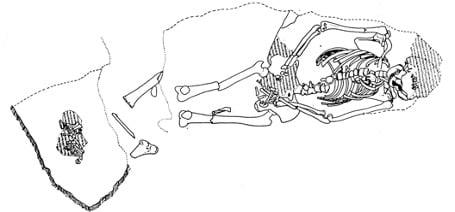
The second burial, carried out in a specially dug elliptical pit, was inside layer 21, in a point where the dates advance by about a millennium with respect to the base. It belongs to a woman, aged about 20, found in a supine position with her arms stretched along her chest, her hands placed on her stomach and her legs no longer in anatomical connection, perhaps due to a landslide of the deposit. Her body had been covered with animal bones, mixed with some lithic artifact, as well as limestone blocks painted with ocher. Among the flint tools appear: four burins, a blade and a scraper. Ocher also appeared at the base of the grave, on the body and particularly on the head, pelvis and feet. Her head was adorned with a small diadem made with pierced deer teeth (Palma di Cesnola, 1992).
A third burial, very partially preserved, was contained in layer 5, in addition to the findings of human remains belonging to different individuals (including two isolated humerus) distributed in the rest of the deposit. The cave, still under study, was excavated only in the area of the atrium, from here came the well-known expressions of movable art which bear witness to an artistic practice that lasted for at least 10.000 years. In a hidden area of the cavity are hidden the only figurative wall paintings of the Italian Paleolithic, consisting of a few handprints and three ocher profiles of horses.
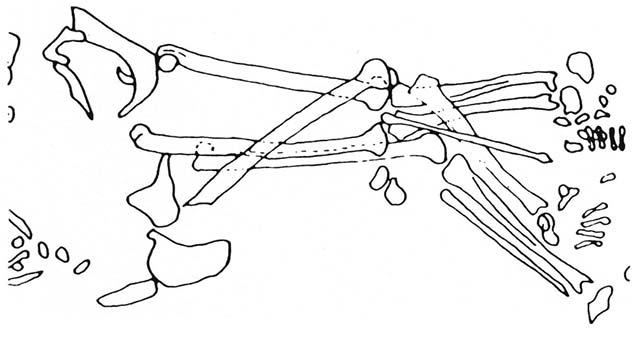
To the individual depositions of S. Maria di Agnano and Paglicci is added a bisoma burial found in the Grotta delle Veneri, in Parabita in the province of Lecce. It is dated to the ancient Epigravettian, around 18.000 years ago and is composed of two individuals of the opposite sex. Unfortunately, the skeletal remains refer only to the pelvis and lower limbs, since the Neolithic made votive holes that destroyed the upper half of the bodies (Cremonesi, Parenti, Romano, 1972; Mallegni, 1997). The deposition had taken place in a natural ellipsoidal pit, exploiting the course of the rocky soil. The abundant traces of ocher indicated that the bodies had been placed on this substance or that they had been extensively sprinkled with it. The grave goods only yielded a pebble painted in ocher and about thirty canines of a deer pierced near the head, perhaps its hairstyle.
From the atrium of the cave come the two female bone statuettes that gave the site its name, dated between the final Gravettian and early Epigravettian, i.e. between 21.000 and 18.000 years ago. In addition to the small female statuettes, about five hundred bones and stones engraved with various geometric motifs were recovered, dating back to the Epiromanellian (end of the Paleolithic).
The somatic components of the individuals of Paglicci, Veneri and Agnano reveal all the classic characteristics of the Cro-Magnon human type and confirm the attenuated sexual dimorphism of the time. The stature was high, around one meter seventy, for women, and one meter eighty for men, the limbs were very robust and the physiognomic features generally presented a broad and low face, a narrow nose with a high bridge, low eye sockets and oblique with a rectangular outline. The features of Paglicci's woman's face have recently been reconstructed and presented by palethnologist Francesco Mallegni, director of the anthropology department of the University of Pisa; the result revealed a woman not unlike the contemporary. Paglicci's boy has even more delicate and harmonious visual traits, defined as Mediterranean. The paleontological examination of the legs of the Ostuni woman, on the other hand, revealed the signs of the muscular efforts typical of walking on steep terrain and the sign of a prolonged seated posture on the heel.
In the last four funerary testimonies mentioned, the essential elements of the practices related to the cult of the dead in the Upper Paleolithic are condensed, and Puglia, like the other Italian regions, is normally testified with the Gravettian, Epigravettian and Epipaleolithic practices. The peculiarities of the deposition, accompanied by ochre, a personal kit and jewels on the body, highlight the great ideological homogeneity of that world. A world that also presents a complex relationship with the caves: now inhabited, now designated as abodes for the dead, now consecrated even with signs of art.
On the basis of current data, the funerary manifestations do not present particular relationships with the artistic expressions of these deposits, however the burials are an evident aspect of the caveman eschatology. Why choose that precise place to "leave" drawings on the wall or on pieces of stone, and why lay down some individuals and not all? Regardless of the relationship (verifiable or not) between burials and art, one must in any case bear in mind that the cave has always been a special place for religious man. Therefore, burial in a cave must have corresponded to a higher social position, intended for special individuals, perhaps shamans, heroes, firstborns, or perhaps victims of holocausts.
Maria Laura Leone
REFERENCES
- AA.VV. - Religiosity in prehistory – Jaca Book – Milan 1991;
- Emmanuel Anati – The religion of the origins. Camuni studies XIV – ed. of the Center – Capo di Ponte 1995;
- Bruno Brizzi – Italy in the Stone Age – Quasar – Rome 1977;
- Alberto Broglio and Janusz Kozlowski – The Paleolithic. Man, environment, cultures – Jaca Book – Milan 1986;
- Daniela Cocchi Genik – Prehistory Manual – Tuscany Museums - Viareggio 1990;
- Donato Coppola – “Preliminary note on the findings in the Grotta di S. Maria di Agnano (Ostuni, BR): the Paleolithic burials and the place of worship"- in Journal of Sc. Preist. – 1992 – 311-227;
- Giuliano Cremonesi – Manifestations of movable art from Epiromanellian levels from Grotta delle Veneri di Parabita and Grotta Marisa near Otranto (Lecce) - Italian Institute of Preist. Protost 1992 – XXVIII – 303-315;
- Giuliano Cremonesi and Raffaello Parenti, Silvana Romano - "Paleolithic skeletons of the Grotta delle Veneri near Parabita (Lecce)" - in Acts XIV Reun. scientist Inst. It. Human Paleontology – 1970 – 105-117;
- Paolo Graziosi – Prehistoric art in Italy – Sansoni – Florence 1973;
- André Leroi-Gourhan – Les religions de la prehistoire – PUF – Paris 1971;
- Francesco Mallegni and Raffaello Parenti – “SAnthropological study of a juvenile skeleton from the Gravettian era collected in the Paglicci Cave (Rignano Garganico)" - in Journal of Archaeology – 1974 – LVIII;
- Francesco Mallegni and Raffaello Parenti – “Grotta delle Veneri. Skeletal remains of the two Gravettian individuals" - in AA.VV. The passion of the origin. Giuliano Cremonesi and prehistoric research in Salento - Lecce 1997 - 232-233;
- Franco Mezzena and Arturo Palma Di Cesnola – “Discovery of a Gravettian burial in the Paglicci Cave (Rignano Garganico)"- in Journal of Sc. Preist. – 1972 – XXVII – 27-50;
- Franco Mezzena and Arturo Palma Di Cesnola – “Paleolithic art in the Gargano"- in Acts Daunia – 1985 – VI – 17-21;
- Franco Mezzena and Arturo Palma Di Cesnola – “New Gravettian burial in the Paglicci Cave"- Gargano promontory – in Journal of Sc. Preist. – 1989-90 – XLII;
- John Mary Peace – Stone Age Italians – Longanesi - Milan 1993;
- Arturo Palma Di Cesnola – “The Paleolithic of Puglia” - in AA.VV. – Puglia from the Palaeolithic to the Late Roman period -1979 – 21-51;
- Arturo Palma Di Cesnola – Paglicci (Rignano Garganico), permanent iconographic exhibition – GERCAP – Foggia 1992;
- Alda Vigliardi – Prehistory introductory course – Garlatti and Razzai - Florence 1992.

